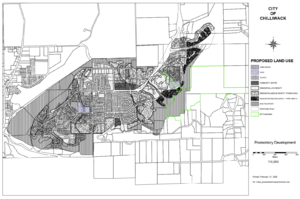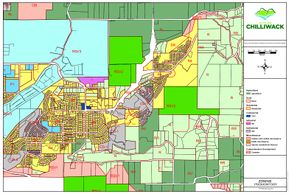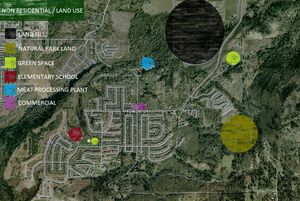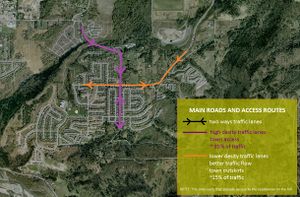Green Infrastructure 2014 Group F - Case Study 3
---> back to group page working group F
Promontory Hill Development
| Name | Promontory Hill Development | |
| Country | Canada | |
| City | Chilliwack | |
| Authors | Andreea Webb | |

| ||
|
| ||
Rationale: Why is this case interesting?
Since my first visit to Canada back in 2009, flying and driving along the Fraser Valley, it was impossible not to notice the vast and lush green landscape in between and surrounding cities. However the cities and the neighborhoods themselves are a whole different story. The Promontory hill could be easily seen from the highway and so were the new developments which clearly cut a grey perimeter of the hill's greenery. The grey area has since tripled and having lived here for 3 years now I could experience the side effects first hand. Due to the topography of the area, the car oriented society, the tight almost waterproof neighborhoods and lack of documentation and public space available it will be a real challenge and very interesting to try find ways in which green infrastructure could be implemented.
Author's perspective
what is your professional/educational background and your relation to the site?
I have studied Landscape Architecture for 3.5 years, in Romania, although I have always thought Architecture is what interests me most. I was born in Bucharest and lived there for most part of my childhood, although I was so young I have quite a number of vivid memories from the Capital, and they all revolved around green spaces - parks, gardens, playgrounds - and plants. I was then brought up in a house with a fairly large yard and garden, in a small city in Timis county. In the Spring the first thing I used to do after coming home from school, was to run in the garden to see what else has bloomed, what is showing signs of life, listen to the birds, pull a few weeds, it just seemed like the natural thing to do, I couldn't image life any different and at the time I didn't realize how special that was and how privileged I was. I left home for university, I did miss having a garden but was too busy to really think about it. I've only realized how important it is to have 'work' to do around the house, space to grow your own, whether is edibles or ornamentals after moving to Canada in 2011.
I've been living in the Promontory area for exactly 3 years. At first it all seems to be done so orderly, the planning of the neighborhoods seems so tidy, so do the front yards on most streets, however as soon as you are past that first impression it all seems to go down. Although there is one great advantage of living on the hill and that would be the great views of the mountains, the valley, the amazing sunsets and city lights.
Landscape and/or urban context of your case
- Biogeography, cultural features, overall character, history and dynamics
- Illustrations: maps; sketches; short descriptive analyses
Biogeography
Chilliwack is a city in the province of British Columbia, Canada. The city is situated on the Fraser River Valley about 100 km from Vancouver, the capital city of BC, and only 5 km from the US border at its most southern tip. Population slightly below 80,000, population density approximately 300/km2. Three rivers traverse the city including the Fraser River, the longest river in the province, Chilliwack River and Vedder River, there are also wetlands such those at the Blue Heron Reserve, as well as a number of man-made water bodies. The city is surrounded by hills, mountains and lakes. The city is
The city is home to one museum, governmental and educational campuses, cultural center, military center, arts center, etc. Everything is small city scale. Just as many other cities in North America, Chilliwack is a relatively new city founded in 1873, with a history shy of 150 years old it's the 3rd oldest municipality in British Columbia. The city doesn't have well outlined downtown core.
- Illustrations
- Yourimage.jpg
your visual
Analytical drawings
- Please use analytical drawing for visualising the conflicts/potentials of your site
1.Non Residential Land Use - Initially the developing plans for the Promontory area seem to make sense, there was a fair amount of land assigned for green space and public use, properties were larger resulting in a larger amount of green space per development. - - However in the last few years more and more areas are being aggressively developed, larger single house properties are rezoned and sometimes up to 40 residential units or more are being built on what was once the garden of one family. - With the exception of the residential developments no other civic needs seem to be addressed. As a results per thousands of units, there are only 2 access roads, 1 primary school and small commercial area. - There is only ONE 'real' park, that provides seating for a maximum of 10 people and 1 playground. The natural park space appears to be getting smaller and smaller by the day. - The meat processing plant has now become part of a residential area (the legality, hygiene, waste are unclear) - The large LANDFILL is now also almost part of the residential developments, the buffer zone being less than 100 meters. Due to the land forms it is quite hidden and many people don't even seem to be aware of it's existence. It tends to smell quite often in the summer there are also other health and ecological concerns to be addressed as well.
- Analytical Drawings
- Your drawing.jpg
your drawing
- Your drawing.jpg
your drawing
Green Infrastructure benefits for this site
Look again at the multiple benefits of green infrastructure - what could be achieved in your site and which are most relevant?
Potential for multifunctionality
Green infrastructure has typically multiple functions. What could be achieved for your site in this respect?
Projective drawings
- How would you like this case to change in the near future? (in 1-2 years)
- you may add a short explanation here
- And how could it look like in 10-15 years?
- you may add a short explanation here
- Projective Drawings
- Yourdrawing.jpg
projective drawing
- Yourdrawing.jpg
projective drawing
- Yourdrawing.jpg
projective drawing
Summary and conclusion
- 100 words approx.
Image Gallery
Please add further images/photos here
- Image Gallery
- Yourimage.jpg
your image text
- Yourimage.jpg
your image text
- Yourimage.jpg
your image text
- Yourimage.jpg
your image text
- Yourimage.jpg
your image text
- Yourimage.jpg
your image text
- Yourimage.jpg
your image text
- Yourimage.jpg
your image text
References
- please add your references here
About categories: You can add more categories with this tag: "", add your categories




